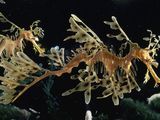Which Animal Adaptation Happened Before The Others?
Adaptation
Adaptation
Evolutionary adaptation, or but accommodation, is the aligning of organisms to their environment in order to improve their chances at survival in that environs.
Subjects
Biology, Ecology, Conservation
Prototype
seahorse
Some creatures, such equally this leafy sea dragon fish (Phycodurus eques) accept evolved adaptations that allow them to blend in with their environment (in this example, seaweed) to avoid the attention of hungry predators.
Photograph past Paul Zahl

In evolutionary theory, adaptation is the biological mechanism by which organisms arrange to new environments or to changes in their current surroundings. Although scientists discussed adaptation prior to the 1800s, it was not until and then that Charles Darwin and Alfred Russel Wallace developed the theory of natural selection. Wallace believed that the development of organisms was connected in some way with adaptation of organisms to changing environmental conditions. In developing the theory of evolution by natural selection, Wallace and Darwin both went beyond simple accommodation by explaining how organisms adapt and evolve. The idea of natural selection is that traits that tin can be passed down permit organisms to adapt to the environs improve than other organisms of the same species. This enables better survival and reproduction compared with other members of the species, leading to development. Organisms tin can adapt to an environment in different means. They can adapt biologically, pregnant they alter body functions. An example of biological accommodation tin can be seen in the bodies of people living at high altitudes, such as Tibet. Tibetans thrive at altitudes where oxygen levels are up to 40 percent lower than at sea level. Breathing air that thin would crusade most people to get ill, merely Tibetans' bodies have evolved changes in their torso chemistry. Most people can survive at high altitudes for a short fourth dimension considering their bodies raise their levels of hemoglobin, a poly peptide that transports oxygen in the blood. Notwithstanding, continuously high levels of hemoglobin are dangerous, and then increased hemoglobin levels are not a good solution to loftier-distance survival in the long term. Tibetans seemed to accept evolved genetic mutations that let them to employ oxygen far more efficently without the need for extra hemoglobin. Organisms can likewise exhibit behavioral adaptation. One example of behavioral adaptation is how emperor penguins in Antarctica oversupply together to share their warmth in the middle of winter. Scientists who studied adaptation prior to the development of evolutionary theory included Georges Louis Leclerc Comte de Buffon. He was a French mathematician who believed that organisms changed over time by adapting to the environments of their geographical locations. Some other French thinker, Jean Baptiste Lamarck, proposed that animals could adapt, laissez passer on their adaptations to their offspring, and therefore evolve. The example he gave stated the ancestors of giraffes might have adapted to a shortage of nutrient from short trees by stretching their necks to reach college branches. In Lamarck'southward thinking, the offspring of a giraffe that stretched its cervix would then inherit a slightly longer neck. Lamarck theorized that behaviors aquired in a giraffe'southward lifetime would affect its offspring. However, it was Darwin's concept of natural selection, wherein favorable traits like a long neck in giraffes suvived not considering of aquired skills, but because just giraffes that had long enough necks to feed themselves survived long enough to reproduce. Natural choice, and then, provides a more compelling mechanism for adaptation and development than Lamarck's theories.

Some creatures, such as this leafy sea dragon fish (Phycodurus eques) have evolved adaptations that allow them to alloy in with their environment (in this case, seaweed) to avoid the attention of hungry predators.
Photograph past Paul Zahl
Substantive
a modification of an organism or its parts that makes it more fit for being. An adaptation is passed from generation to generation.
behavioral adaptation
Noun
way an organism acts in order to survive or thrive in its environment.
biological adaptation
Noun
physical change in an organism that results over time in reaction to its surroundings.
evolution
Noun
modify in heritable traits of a population over time.
naturalist
Substantive
person who studies the natural history or natural evolution of organisms and the environment.
Noun
process by which organisms that are ameliorate -adapted to their environments produce more offspring to transmit their genetic characteristics.
Noun
process by which organisms that are ameliorate -adapted to their environments produce more offspring to transmit their genetic characteristics.
Source: https://www.nationalgeographic.org/encyclopedia/adaptation/
Posted by: whitesains1990.blogspot.com

0 Response to "Which Animal Adaptation Happened Before The Others?"
Post a Comment